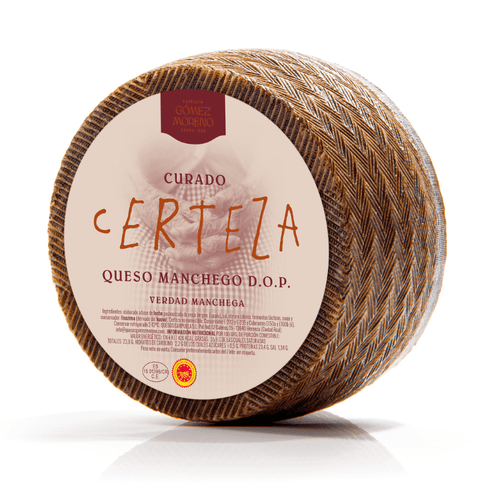Refine
view allCheese
-
Asiago(2)
-
BellaVitano(3)
-
Beverages(124)
-
Bundle(21)
-
By the Pound or Less(109)
-
Cheddar(22)
-
Coffee(80)
-
Coffee(41)
-
Emmenthaler(1)
-
Fondue(2)
-
Fontina(2)
-
For The Bar(136)
-
Gift Cards(1)
-
Goat Cheese(14)
-
Gouda(20)
-
Grana Padano(5)
-
Kitchen(9)
-
Manchego(13)
-
Meats(187)
-
Olives & Capers(94)
-
Other(6)
-
Pantry(895)
-
Pecorino(63)
-
Pecorino Romano(20)
-
Pizza Sauce(11)
-
Primo Sale(16)
-
Reggianito(1)
-
Sweets & Snacks(658)
-
Swiss(4)
-
Taleggio(1)
-
Tea(55)
Olives & Capers
Oil & Vinegar
Rice Types
Fruits & Veggies
Brand
Manchego
13 products
What is Manchego cheese?
This sheep's milk cheese comes from the La Mancha region of Spain, which is also famous for the legendary figure of Don Quixote. Authentic Manchego cheese is only made from the milk of the sheep of the same name. The flavor of the cheese depends on how long it has been aged. This cheese can either be nutty, sweet, or grassy and tangy. The texture is semi-soft.
How is Manchego cheese made?
Traditionally, This Spanish cheese is made with unpasteurized milk. However, when it is produced and distributed on a large scale, it tends to contain pasteurized milk instead. The cheese curds develop inside woven grass molds or baskets, which leaves not only a grassy, earthy taste, but a distinct zigzag imprint on the cheese.
How long is Manchego aged?
The number of months this pillar of Spanish Cuisine is aged affects the cheese types. Our types of Manchego that are aged three months are relatively soft with a fresh floral and grassy flavor. This three-month-old cheese type is known as Semi Curado. At six months, Curado Manchego cheese is slightly firmer and has a fuller, nuttier flavor. At 12 months and beyond, the texture of Manchego Viejo cheese becomes firm, if not crumbly, and the taste becomes sharper and more peppery.
How should I eat Manchego cheese?
The Manchego cheese recipes you should use all depends on the cheese types. Depending on what kind of flavor profile you want your dish to have, it can be used in everything from salads to sandwiches to mac and cheese. It also pairs well with bacon, figs, and even chocolate. Act like a true Spaniard and pair it with a mature Spanish wine.
What is the difference between Manchego and Parmigiano Reggiano?
Parmigiano Reggiano is a cow's milk cheese that is produced using raw milk and has a natural rind. It is typically made in the provinces of Parma, Modena, Reggio Emilia, and parts of Bologna and Mantua in Italy. Manchego, on the other hand, is a sheep's milk cheese that is made using the milk of the manchega sheep in the Spanish provinces of Albacete, Ciudad Real, Cuenca and Toledo. The cheese has a unique taste, which is often described as nutty and slightly tangy. Manchego is a common ingredient in Spanish tapas and is often served with a drizzle of olive oil. Both Parmigiano Reggiano and its Spanish counterpart are high-quality cheeses that are enjoyed for their distinct flavors and textures.


Refine
view allCheese
-
Asiago(2)
-
BellaVitano(3)
-
Beverages(124)
-
Bundle(21)
-
By the Pound or Less(109)
-
Cheddar(22)
-
Coffee(80)
-
Coffee(41)
-
Emmenthaler(1)
-
Fondue(2)
-
Fontina(2)
-
For The Bar(136)
-
Gift Cards(1)
-
Goat Cheese(14)
-
Gouda(20)
-
Grana Padano(5)
-
Kitchen(9)
-
Manchego(13)
-
Meats(187)
-
Olives & Capers(94)
-
Other(6)
-
Pantry(895)
-
Pecorino(63)
-
Pecorino Romano(20)
-
Pizza Sauce(11)
-
Primo Sale(16)
-
Reggianito(1)
-
Sweets & Snacks(658)
-
Swiss(4)
-
Taleggio(1)
-
Tea(55)











![President Don Bernardo Manchego Cheese Wedge, 5.28 oz [Pack of 3] Cheese President](http://supermarketitaly.com/cdn/shop/files/president-don-bernardo-manchego-cheese-wedge-528-oz-pack-of-3-cheese-president-324606_{width}x.png?v=1754345723)